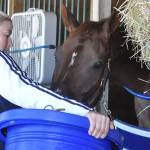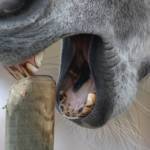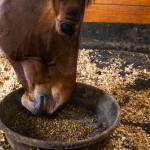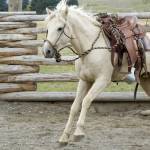Thoroughbred Horse: Speed, Beauty, and Agility

Few breeds of horses evoke the degree of superlatives used to describe the Thoroughbred horse. From the majesty of the stallion standing alone in his paddock, to the glory of the athlete thrusting a nose ahead at the finish line, with the preciousness of the foal peering out from behind the curtain of her dam’s tail in between, there is an untold volume of written words and artist’s renderings that attempt to describe these horses. Perhaps the most recognized of all equine breeds, thanks in large part to their daring feats on and off the racetrack, the breed’s very name is synonymous with words such as well bred, excellent and first-rate. Even these descriptions fall short of capturing the essence of one of the horse world’s noblest ambassadors.
For such a storied animal, the Thoroughbred is a relatively young breed. Selective breeding for a horse that could carry weight over distance at a sustained speed began around the beginning of the 17th century. Three horses are named as the foundation sires, the Byerly Turk, the Darley Arabian, and the Godolphin Barb.
All three were imported to England from the Middle East and at least one of them can also be credited with the first of many “Cinderella” stories that abound in the breed’s history. The Godolphin Barb was foaled in Yemen, traveled from Syria to Tunis and then was sent on to Paris where it is rumored that he was a gift to the King of France. It is said he was discovered pulling a water cart through the streets of Paris by an English gentleman with a good eye for horseflesh. He was purchased and transported to England where he sired, among others, the great racehorse and sire Matchem.
The success of these three stallions launched a wave of importation of oriental-bred horses that were crossed with native English mares. The result was a distinctive horse that possessed the beauty, refinement and added speed of its Arabian ancestors and the stout bone structure and heavier muscling of its English forebears. Today’s Thoroughbreds encompass these traits and others refined over three centuries of selective breeding. They average 16 hands, have athletic frames, deep sloping shoulders, powerful muscling over the hips and thighs and long clean legs with pronounced tendons. The predominant colors that grace their short coats are bay, chestnut, black and gray. There are some roans and very rarely a white horse will be accepted for registry.
The first attempt to establish a registry was made by Englishman James Weatherby in 1791. He researched privately held records and developed the first General Stud Book, which listed the pedigrees of 387 mares that traced back to the foundation sires. The proliferation of these distinctive horses created an industry that today spreads across the world. Thoroughbreds can be found in almost every country. The American Stud Book, started in 1873, was taken over by The Jockey Club in 1896. In that year the foal crop was listed as being 3,000 strong. At the close of 1999 the estimated foal crop for the United States alone was 36,265. The Jockey Club states that in 1998, the last year for which there are complete statistics available, 109,228 Thoroughbred foals were registered throughout the world.
The incredible growth of the breed has helped to support the development and expansion of entire industries. The Jockey Club estimates that Thoroughbred racing generates nearly $500 million in government revenue each year. Racetracks throughout the world provide employment for a myriad of people to work not only with the horses but also to provide the services necessary to keep the tracks operating. Supportive enterprises such as veterinary clinics, research facilities, tack suppliers, and feed companies have also benefited from the expansion of the Thoroughbred industry.








